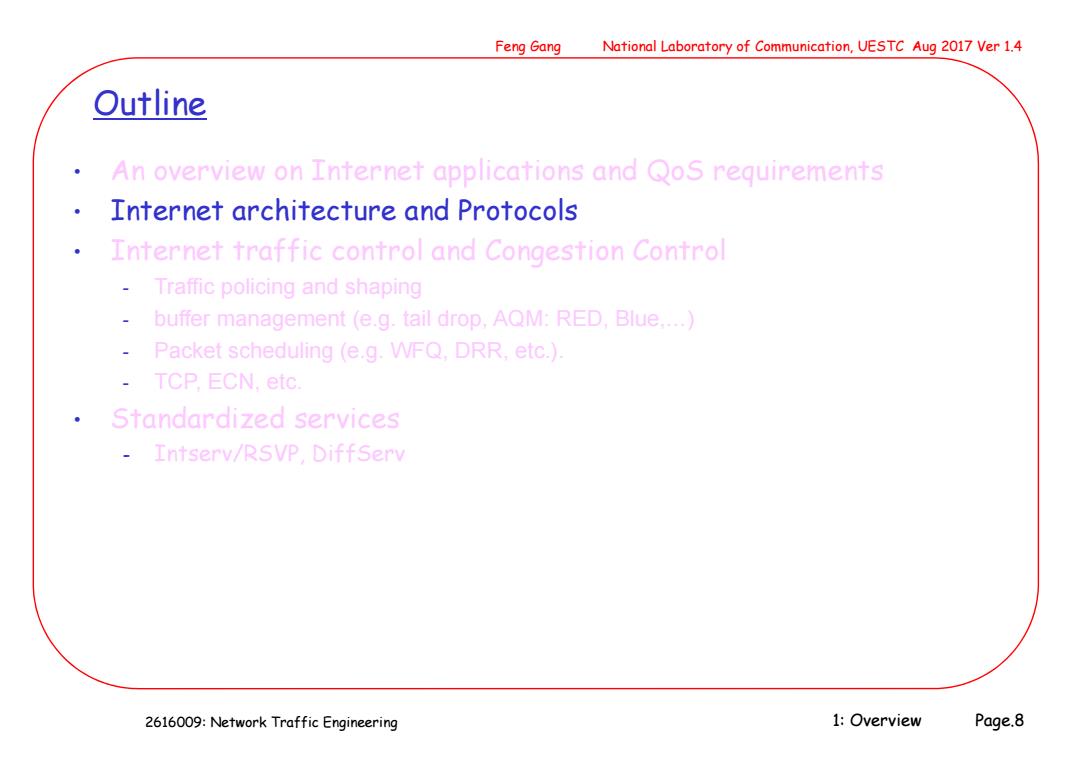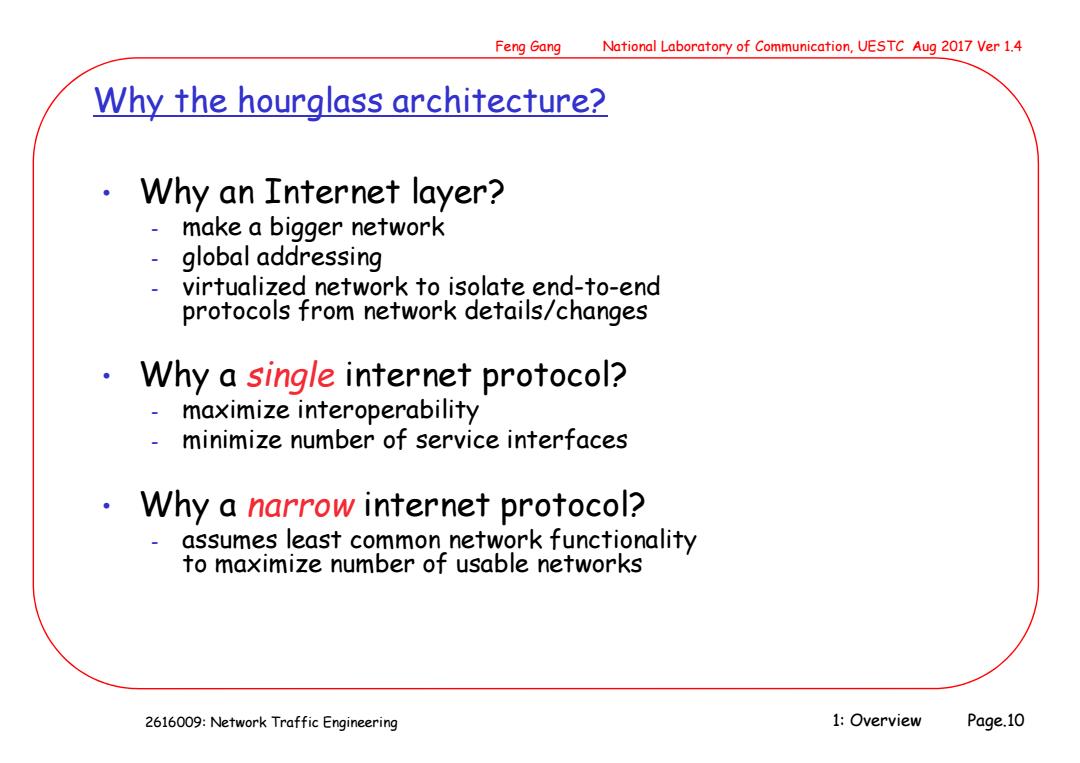
Feng Gang National Laboratory of Communication,UESTC Aug 2017 Ver 1.4 What causes... Lack of bandwidth multiple flows are competing for a limited amount of bandwidth Too much delay -packets have to traverse many network devices and links that add up to the overall delay,and/or long queueing delay at routers (congestion) Variable delay sometimes there is a lot of other traffic which results in more delay Drops-packets have to be dropped when a link is congested (congestion) 2616009:Network Traffic Engineering 1:Overview Page.6
2616009: Network Traffic Engineering Feng Gang National Laboratory of Communication, UESTC Aug 2017 Ver 1.4 1: Overview Page.6 What causes ... - Lack of bandwidth – multiple flows are competing for a limited amount of bandwidth - Too much delay – packets have to traverse many network devices and links that add up to the overall delay, and/or long queueing delay at routers (congestion) - Variable delay – sometimes there is a lot of other traffic which results in more delay - Drops – packets have to be dropped when a link is congested (congestion)

Feng Gang National Laboratory of Communication,UESTC Aug 2017 Ver 1.4 Which Applications Have Which QoS Requirements? Throughput Delay Loss Jitter Interactive (e.g.Telnet) Low Low Low Not Important Batch (e.g. Not FTP) High Not Important Low Important Fragile (e.g. Low Low None Not SNA) Important Voice Low Low and Low Low Predictable Video High Low and Predictable Low Low 2616009:Network Traffic Engineering 1:Overview Page.7
2616009: Network Traffic Engineering Feng Gang National Laboratory of Communication, UESTC Aug 2017 Ver 1.4 1: Overview Page.7 Which Applications Have Which QoS Requirements? Throughput Delay Loss Jitter Interactive (e.g. Telnet) Batch (e.g. FTP) Fragile (e.g. SNA) Voice Low Low Not Important Not Important High Low Low Not Important None Not Important Low Low Low Low and Predictable Low Low Video High Low Low Low and Predictable

Feng Gang National Laboratory of Communication,UESTC Aug 2017 Ver 1.4 Outline An overview on Internet applications and QoS requirements 。 Internet architecture and Protocols 。 Internet traffic control and Congestion Control Traffic policing and shaping buffer management (e.g.tail drop,AQM:RED,Blue....) Packet scheduling (e.g.WFQ,DRR,etc.). TCP.ECN,etc. Standardized services Intserv/RSVP,DiffServ 2616009:Network Traffic Engineering 1:Overview Page.8
2616009: Network Traffic Engineering Feng Gang National Laboratory of Communication, UESTC Aug 2017 Ver 1.4 1: Overview Page.8 Outline • An overview on Internet applications and QoS requirements • Internet architecture and Protocols • Internet traffic control and Congestion Control - Traffic policing and shaping - buffer management (e.g. tail drop, AQM: RED, Blue,…) - Packet scheduling (e.g. WFQ, DRR, etc.). - TCP, ECN, etc. • Standardized services - Intserv/RSVP, DiffServ

Feng Gang National Laboratory of Communication,UESTC Aug 2017 Ver 1.4 Internet protocols email W phone... SMTP HTTP RTP... TCP UDP. The Internet Protocol Hourglass IP Ethernet PPP CSMA async sonet... copper fiber radio... 2616009:Network Traffic Engineering 1:Overview Page.9
2616009: Network Traffic Engineering Feng Gang National Laboratory of Communication, UESTC Aug 2017 Ver 1.4 1: Overview Page.9 Internet protocols email WWW phone... SMTP HTTP RTP... TCP UDP… IP Ethernet PPP… CSMA async sonet... copper fiber radio... The Internet Protocol Hourglass

Feng Gang National Laboratory of Communication,UESTC Aug 2017 Ver 1.4 Why the hourglass architecture? Why an Internet layer? - make a bigger network global addressing virtualized network to isolate end-to-end protocols from network details/changes Why a single internet protocol? maximize interoperability minimize number of service interfaces Why a narrow internet protocol? assumes least common network functionality to maximize number of usable networks 2616009:Network Traffic Engineering 1:Overview Page.10
2616009: Network Traffic Engineering Feng Gang National Laboratory of Communication, UESTC Aug 2017 Ver 1.4 1: Overview Page.10 Why the hourglass architecture? • Why an Internet layer? - make a bigger network - global addressing - virtualized network to isolate end-to-end protocols from network details/changes • Why a single internet protocol? - maximize interoperability - minimize number of service interfaces • Why a narrow internet protocol? - assumes least common network functionality to maximize number of usable networks